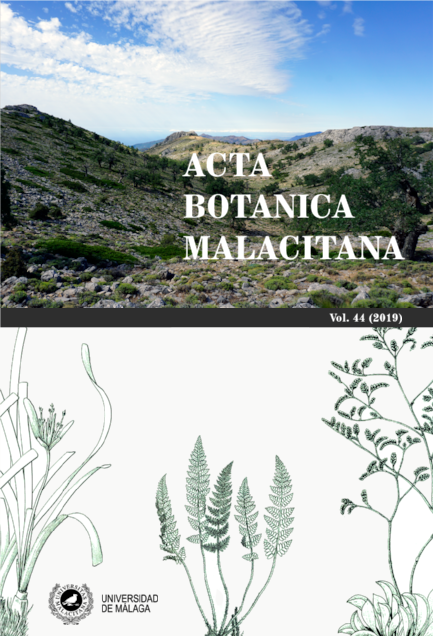A new species of Linaria sect. Supinae from Sierra de Gredos (Sistema Central mountains, Iberian Peninsula)
DOI:
https://doi.org/10.24310/abm.v44i0.6679Resumen
Abstract
Una especie nueva de Linaria sect. Supinae en la Sierra de Gredos (Sistema Central, Península Ibérica)
Linaria vettonica Luceño, Mazuecos & P. Vargas, a new species of Linaria sect. Supinae, is described. It is a narrow endemic inhabiting the southern hills of the western and central massifs of Sierra de Gredos (Sistema Central mountains, Iberian Peninsula). The five populations found occur on siliceous, sandy soils of Quercus pyrenaica woodland clearings and slopes. L. vettonica can be distinguished from Linaria caesia by the densely glandular-pubescent inflorescence, dark purple corolla and brown seeds with tuberculate disc, and from L. aeruginea by its erect fertile stems and dark purple -never blackishcorolla.
Key words: Linaria, Sierra de Gredos, narrow endemic, taxonomy, seed micromorphology.
Resumen
Se describe Linaria vettonica Luceño, Mazuecos & P. Vargas, una nueva especie de Linaria sect. Supinae. Se trata de un endemismo restringido que se distribuye por las vertientes meridionales de los macizos occidental y central de la Sierra de Gredos (Sistema Central, Península Ibérica). Las cinco poblaciones encontradas aparecieron sobre suelos arenosos silíceos en claros y laderas de bosques de Quercus pyrenaica. L. vettonica se distingue de L. caesia por sus inflorescencias densamente glandular-pubescentes, corolas de color púrpura oscuro y semillas marrones con disco ornamentado con numerosos tubérculos. De L. aeruginea se distingue por sus tallos fértiles erectos y sus flores de color púrpura oscuro, nunca negruzcas.
Palabras clave: Linaria, sierra de Gredos, endemismo restringido, taxonomía, micromorfología de semillas.
Descargas
Métricas
Citas
Blanca, G., Cueto, M., & Fuentes, J. (2017). Linaria becerrae (Plantaginaceae), a new endemic species from the southern Spain, and remarks on what Linaria salzmannii is and is not. Phytotaxa, 298(3), 261-268. http://dx.doi.org/10.11646/phytotaxa.298.3.5
Blanca, G., Cueto, M., Fuentes, J., Sáez, L., & Tarifa, R. (2018). Linaria qartobensis sp. nov. (Plantaginaceae) from the southern Iberian Peninsula. Nord. J. Bot., 36(8), e01914. https://doi.org/10.1111/njb.01914
Blanco-Pastor, J. L., Ornosa, C., Romero, D., Liberal, I. M., Gómez, J. M., & Vargas, P. (2015). Bees explain floral variation in a recent radiation of Linaria. J. Evolution. Biol., 28(4), 851-863. https://doi.org/10.1111/jeb.12609
Blanco-Pastor, J. L., & Vargas, P. (2013). Autecological traits determined two evolutionary strategies in Mediterranean plants during the Quaternary: low differentiation and range expansion versus geographical speciation in Linaria. Mol. Ecol., 22(22), 5651-5668. https://doi.org/10.1111/mec.12518
Blanco-Pastor, J. L., Vargas, P., & Pfeil, B. E. (2012). Coalescent simulations reveal hybridization and incomplete lineage sorting in Mediterranean Linaria. PLOS ONE, 7(6), e39089. https://doi.org/10.1371/journal.pone.0039089
Buira, A., Aedo, C., & Medina, L. (2016). Spatial patterns of the Iberian and Balearic endemic vascular flora. Biodivers. Conserv., 26(2), 479-508. https://doi.org/10.1007/s10531-016-1254-z
Fernández-Mazuecos, M., Ferrer-Gallego, P. P., Miguel, M., Glover, B. J., & Sáez, L. (2018). A synopsis of the Iberian clade of Linaria subsect. Versicolores (Antirrhineae, Plantaginaceae) based on integrative taxonomy. Plant Syst. Evol., 304(7), 871-884. https://doi.org/10.1007/s00606-018-1517-0
Fernández?Mazuecos, M., Blanco?Pastor, J. L., Juan, A., Carnicero, P., Forrest, A., Alarcón, M., Vargas, P., & Glover, B. J. (2019). Macroevolutionary dynamics of nectar spurs, a key evolutionary innovation. New Phytol., 222(2), 1123-1138. https://doi.org/10.1111/nph.15654
Juan, A., Blanca, G., Cueto, M., Fuentes, J., & Sáez, L. (2018). Linaria argillicola (Plantaginaceae), a new species of L. sect. Supinae from the southern Iberian Peninsula. Phytotaxa, 343(2), 127-138. http://dx.doi.org/10.11646/phytotaxa.343.2.3
Sáez, L., & Bernal, M. (2009). Linaria Mill. In S. Castroviejo, A. Herrero, C. Benedí, E. Rico, & J. Güemes (Eds.), Flora iberica XIII (Plantaginaceae – Scrophulariaceae) (pp. 232-324). Madrid: CSIC.
Sutton, D. A. (1988). A revision of the tribe Antirrhineae. Oxford: Oxford University Press.
Valdés, B. (1970). Revisión de las especies europeas de Linaria con semillas aladas. An. Univ. Hipalense., 7, 1-288.
Vargas, P., & García, B. (2008). Plant endemics to Sierra de Gredos (central Spain): taxonomic, distributional, and evolutionary aspects. Anales Jard. Bot. Madrid, 65(2), 353-366. https://doi.org/10.3989/ajbm.2008.v65.i2.298
Vigalondo, B., Fernández-Mazuecos, M., Vargas, P., & Sáez, L. (2015). Unmasking cryptic species: morphometric and phylogenetic analyses of the Ibero-North African Linaria incarnata complex. Bot. J. Linn. Soc., 177(3), 395-417. https://doi.org/10.1111/boj.12251
Descargas
Publicado
Cómo citar
Número
Sección
Licencia
Toda la información relacionada con la licencia de uso de los trabajos publicados en Acta Botanica Malacitana y con los derechos de autor se pueden consultar en nuestra Política Editorial.







1.png)


